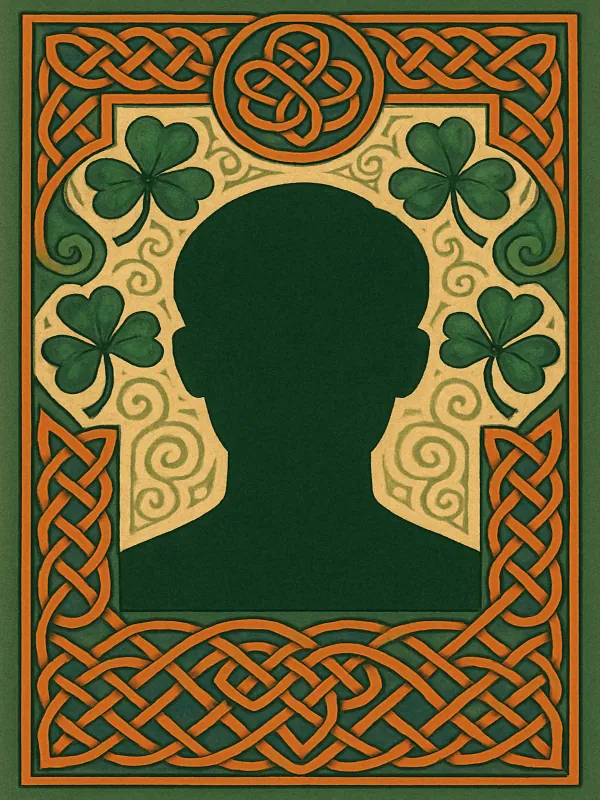Rev. Thomas Conefrey
Biography

Early Life and Family Background
Reverend Thomas Conefrey was born in early 1838 in Drumgilra, in the parish of Cloone, County Leitrim. He was the son of William Conefrey (c.1795–1865) and Sarah Kane. Baptismal records show that he was christened on 19 April 1838 in the local Catholic parish. Raised in a devout Irish Catholic farming family, Rev. Conefrey grew up during a time of great social change in Ireland. Several of his relatives also entered the priesthood, reflecting a strong clerical tradition in the family. Little is recorded of his early education, but it is likely that he attended local schools before undertaking seminary studies (possibly at St. Patrick’s College, Maynooth, like many contemporaries) to prepare for the priesthood. He was ordained a Catholic priest during the mid-19th century and began serving in the Diocese of Ardagh and Clonmacnois, which includes counties Leitrim and Longford.
Clerical Career and Parish Appointments
Rev. Conefrey spent his early ministry as a curate in various parishes before rising to the position of parish priest. In 1879, he was appointed the Parish Priest of Drumlish in County Longford. Drumlish was a rural parish where tenant farming was the way of life for most of his flock. Rev. Conefrey’s tenure in Drumlish (1879–1900) coincided with a turbulent period in Irish agrarian history, and he soon became deeply involved in the struggles of local tenant farmers. He gained a reputation as an able leader and mediator, using his position to advocate for the rights of the poor. In 1900, after two decades in Drumlish, he was transferred to County Longford’s Killoe parish, where he served as parish priest from 1900 until his death in 1917. This move kept him within the same diocese and near the communities he had long supported. In both Drumlish and Killoe, Rev. Conefrey was known as a compassionate pastor and a stalwart supporter of his parishioners’ welfare. His clerical career thus spanned nearly forty years of service, during which he witnessed and influenced significant social changes in rural Ireland.
Leadership in Agrarian Activism during the Land War
As parish priest of Drumlish, Rev. Conefrey emerged as a prominent figure in the Irish Land War—a nationwide campaign in the late 1870s and 1880s against landlordism and for tenant rights. The Land War in County Longford was especially intense on the estate of the local landlord, the 7th Lord Granard, who owned much of the land around Drumlish. Economic distress and a series of bad harvests left many Drumlish tenants unable to pay high rents, and Lord Granard (along with other landlords in the area) threatened mass evictions for non-payment. In response, the Irish National Land League mobilized to resist unjust evictions. Rev. Conefrey became a leader of the Land League in the Drumlish-Ballinamuck district, working closely with local organizer James McDonnell of Melkagh. Rev. Conefrey not only provided moral guidance but also strategic leadership; he was instrumental in coordinating tenant resistance and maintaining unity among the farmers. According to historian Patrick Maume, Rev. Thomas Conefrey “led the Land League and [later the] Plan of Campaign on the estate of Lord Granard” during this period. The Plan of Campaign (a rent withholding strategy in the late 1880s) was a follow-up phase of agrarian agitation, and Rev. Conefrey’s continued leadership in it underscored his commitment to securing fair rents and land ownership for tenants. He frequently acted as an intermediary between tenants and authorities, advocating peaceful protest but firm resolve. His prominence as a clerical activist made him one of the notable “Land League priests” who stood up to the landlord system in the 1880s.
The Drumlish Eviction Standoff of January 1881
On 12–13 January 1881, Rev. Conefrey played a pivotal role in a dramatic confrontation that became a local legend of the Land War. The conflict began when a court official, under police escort, arrived to serve an eviction notice on a tenant farmer, Thomas Rogers of Derawley (a townland in Drumlish). Anticipating the eviction, hundreds of local people from Drumlish and neighboring parishes gathered on the farm to block the process. They were determined to resist Rogers’s eviction, and many armed themselves with improvised weapons such as farm tools and hay-forks. The Royal Irish Constabulary forces on the scene, initially few in number, were met with this human barricade and found themselves unable to proceed. As word spread, even larger crowds assembled, and by the next day the authorities had summoned reinforcements – including a detachment of armed police and a troop of cavalry from Longford town – to assert the landlord’s writ. A volatile standoff ensued outside the beleaguered farmhouse (as depicted in the illustration, with tenant farmers massed at left and armed constabulary at right). At this critical moment, Rev. Conefrey stepped forward to prevent an eruption of violence. Moving courageously between the lines of bayonets and barricades, he appealed to both sides for restraint. Eyewitness accounts and local lore recount that Rev. Conefrey implored the aggrieved tenants to disarm and disperse peacefully, even as he negotiated with the officers in charge of the police and soldiers. His moral authority and calm diplomacy proved decisive. Remarkably, bloodshed was averted: the tenants stood down, and in turn the constabulary and cavalry agreed to withdraw without enforcing the eviction. The eviction notice was never served on Thomas Rogers, allowing him to remain in his home. Contemporary reports noted that Rev. Conefrey’s intervention had prevented what could have been a violent clash. In the aftermath, the government did react by arresting dozens of men for their part in the resistance (85 local men were taken into custody and 10 faced trial, though they were later released without serious penalty). Nonetheless, the January 1881 incident in Drumlish became an iconic victory for the Land League. Rev. Conefrey’s leadership that day—placing himself literally between his parishioners and the forces of the Crown—earned him enduring respect in County Longford. It was said that through his shrewd yet peaceful diplomacy, he avoided bloodshed and forever won the gratitude of the people.
“A Short History of the Land War”
To inform a wider audience about the tenant struggle in Drumlish, Rev. Conefrey later documented these events and their background in a pamphlet. In 1881, amid the ongoing Land War, he wrote A Short History of the Land War in Drumlish in 1881, which recounted the causes and course of the agrarian agitation in his parish. This work serves as a contemporary chronicle of the local Land League campaign. It was published in book form some years afterward (in 1892) under the authorship of “An Irish Priest,” a pseudonym understood to be Rev. Conefrey. The booklet, roughly 78 pages in length, provides a first-hand account of the landlord-tenant conflict on Lord Granard’s estate and offers insight into Rev. Conefrey’s perspective on the justice of the tenants’ cause. In it, he describes the struggles of 1881 and proudly reports the ultimate outcomes achieved by the tenant farmers. For example, Rev. Conefrey writes of the tenants’ hard-won progress toward land ownership, stating that “it is my pleasing duty to narrate that the tenants…have achieved a complete, permanent and final victory” in their fight for the land. By the early 1890s, many Drumlish tenants were able to purchase their farms under the Ashbourne Land Act of 1885, at affordable terms that effectively turned their rent into nominal purchase annuities. Rev. Conefrey’s history praises both the tenants’ perseverance and the cooperation of others (notably the trustees of Maynooth College, who held a mortgage on the Granard estate and eventually forgave years of back rent to facilitate a settlement). A Short History of the Land War thus stands as an important primary source on the Land War in County Longford, and it reflects Rev. Conefrey’s dual role as participant and historian of that conflict. Through this publication, he sought to ensure that the story of the Drumlish tenants’ resistance—and the peaceful resolution he helped broker—would not be forgotten.
Later Years in Killoe and Death
In 1900, after the agrarian tumult had subsided and as part of routine clerical reassignments, Rev. Conefrey was appointed parish priest of Killoe, a parish just east of Longford town. By then in his early 60s, Rev. Conefrey shifted his focus back to the pastoral and spiritual care of his parishioners, as Ireland entered the 20th century with the land question gradually being settled by legislative reforms. In Killoe, he served as an experienced elder clergyman, ministering to the community and continuing to uphold the nationalist and social principles he had championed. While no longer in the forefront of political agitation, he remained a respected figure. Family connections stayed close as well – in August 1917, his young nephew Rev. Peter Conefrey was assigned to Killoe as a curate, effectively coming under Thomas’s mentorship in the final weeks of the older priest’s life. Rev. Thomas Conefrey died on 4 September 1917 at the Killoe parochial house, after nearly four decades of service in the priesthood. He was 79 years old. News of his passing was met with tributes to his leadership and character; parishioners remembered him not only for his spiritual guidance but also for his courage during the Land War years. Rev. Conefrey was laid to rest after a well-attended funeral, likely in the local cemetery among the community he had served. His death marked the end of an era for the Longford parishes of Drumlish and Killoe, which had been indelibly shaped by his presence.
Legacy and Historical Significance
Rev. Thomas Conefrey’s life bridged the Ireland of the Great Famine generation and that of the revolutionary early 20th century, and his legacy endures primarily due to his role in the Land War. He exemplified the socially conscious Catholic priest who stood with his people in their hour of need. By advocating peaceful resistance and negotiating solutions, Rev. Conefrey helped set a model for clergy involvement in community struggles. The famous 1881 standoff at Drumlish, in which he prevented bloodshed, remained a proud memory in County Longford and is often recounted in local histories. Generations later, the community has not forgotten his contributions. In November 2021, a commemorative Land War Memorial was unveiled in Drumlish, featuring illustrations of the 1881 confrontation and honoring those who took part, including Rev. Conefrey, for their bravery and commitment to justice. This memorial, along with parish chronicles and heritage publications, ensures that Rev. Conefrey’s name is remembered in Longford. His written account, A Short History of the Land War, also remains a valuable reference for historians studying that turbulent period. Through his actions and writings, Rev. Thomas Conefrey secured a place in the annals of Irish rural history as a compassionate pastor and a champion of the oppressed. His story highlights the influential role that local leadership – and in particular, the moral authority of a parish priest – could play in quelling violence and achieving reform during one of Ireland’s most significant social upheavals.
Works
- A Short History of the Land War in Drumlish in 1881 (1892)
References
- Holdings: A short history of the land war in Drumlish in 1881,
- Longford County Council – Land War Memorial, Drumlish
- Patrick Maume, “Conefrey, Peter,” in Dictionary of Irish Biography (2009)
- The Land War | Drumlish Heritage & History Society
- The Mortgage Papers of St Patrick’s College, Maynooth, 1871-1923
